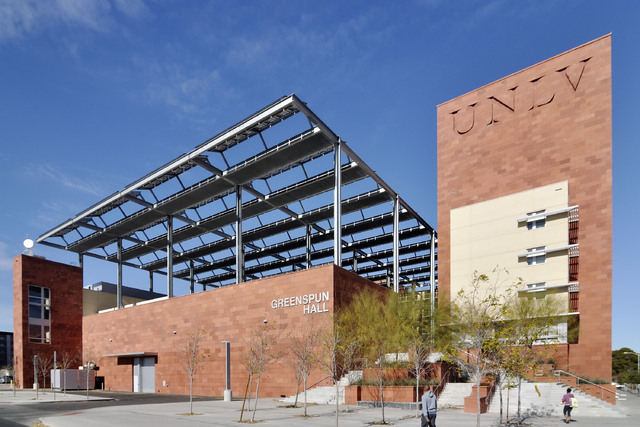Review: UNLV journalism school needs overhaul

The school of journalism at the University of Nevada, Las Vegas — hamstrung by weak leadership and aimless curriculum — needs an overhaul to raise completion rates and produce more competitive graduates, according to an external review commissioned by UNLV.
The study, written by journalism professors Marianne Barrett from Arizona State University and Dorothy Bland from the University of North Texas, says the biggest obstacle facing UNLV’s Hank Greenspun School of Journalism and Media Studies is students’ inability to finish their degrees within six years. Blaming curriculum bottlenecks and a lack of academic advisers, the report says only 26 percent of students at the school graduated on time in 2007, while UNLV as a whole had a graduation rate of 44 percent.
The report was especially critical of program Chairman Lawrence Mullen, who “seems to lack an understanding of the key metrics related to enrollment, retention, graduation and budget.”
Mullen, who has led the journalism school for two years, has taught at UNLV since 1994. Before that, he was an assistant professor at Augustana College in Sioux Falls, S.D. He said the review wasn’t surprising, noting that his job is sometimes overwhelming because he’s “caught between the demands of faculty and students.” Mullen is a theorist on media studies who teaches courses based largely on his research about online role-playing games like “Second Life.”
“It’s tremendous work,” Mullen said. “I think for any director — almost all directors — it’s a difficult position.”
The university hasn’t made the review public since it was received May 8, but the Las Vegas Review-Journal obtained a copy of it last week. Robert Ulmer, dean of the Greenspun College of Urban Affairs, says he and Mullen are assembling a plan to carry out its recommendations, including expanding class sizes to allow students to graduate more quickly. Mullen said he also has been reaching out to faculty members for input, noting that in the past year some professors have resisted adding more students to their classes.
“We want people to question us,” Ulmer said. “We want people to provide us feedback. We want to grow and develop, and we want to give students at UNLV the best possible education we can give them. That means confronting our weaknesses.”
Some current and former students found the review’s results unsurprising — especially Barrett and Bland’s concerns about a shortage of advisers. The Greenspun College of Urban Affairs employs only two advisers to work with 2,500 students, six times the standard ratio established by the National Academic Advising Association.
The school has a shortage of classes needed to graduate, making it tougher for students to earn degrees on time. Its rules on course prerequisites are unclear. There are also low enrollment caps in certain courses.
“When you’re a degree-seeking student, you’re on a path to graduation and that’s part of what you’re paying tuition for,” said Rebecca Koonce, who graduated in 2013 with a degree in integrated marketing communications with a focus in advertising. “The college doesn’t really initiate a lot of guidance.”
Barrett and Bland also noted that the ethnic and racial makeup of the school’s faculty doesn’t reflect its diverse student base — there are no people of color teaching at the school full-time even though nearly a third of the population in Clark County is Hispanic and 12 percent is black. The reviewers, however, commended the fact that half of the school’s teachers are women.
UNLV’s journalism school also lacks focus, the reviewers said, placing too much emphasis on media theory at the expense of providing students with skills to compete in a rapidly changing and increasingly competitive industry.
Among their recommendations, they suggested that Mullen participate in a leadership training seminar and that the school develop a written plan with faculty and staff input by the end of the fall semester. Barrett and Bland also urged the school to work harder to engage alumni, updating its website daily and generating a quarterly alumni e-newsletter.
Despite the problems identified, they lauded the school’s “impressive” 12,000-square-foot broadcast facility and noted that the professional staff operating the school’s radio and TV station are “energetic and well trained.”
The unaccredited school commissions an external performance assessment about once a decade. Until recently, UNLV was pursuing accreditation but stopped “because there’s no evidence that accredited programs are better than non-accredited programs,” Mullen said.
The commissioned report was preceded by a self-study and will be followed by a response from Mullen. UNLV plans to make all of the documents public in December by submitting them to the Nevada System of Higher Education for its regular meeting at UNLV.
“The goal of this review is to have continuous improvement,” said UNLV Senior Vice Provost Carl Reiber. “Sometimes programs come back outstanding with a few recommendations, and sometimes there are more. In this case, Dean Ulmer asked that someone really, really look at the program critically to point us toward areas that need improvement so that we can become the journalism and media studies program of the future.”
Contact Ana Ley at aley@reviewjournal.com or 702-224-5512. Find her on Twitter @la__ley.